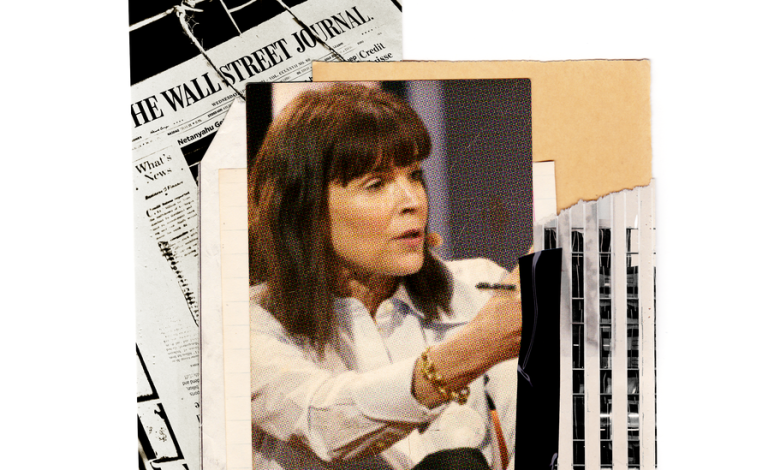The Remaking of The Wall Street Journal

Last month, Emma Tucker, the new editor in chief of The Wall Street Journal, gathered the newsroom to share a blunt message: The media industry had morphed “beyond recognition” and The Journal needed to adapt, or be left behind.
“We don’t want to be the German car industry of news publishing,” she joked to the hundreds of staff members listening.
Ms. Tucker, who took over as top editor in February, was addressing a group that had been, to a large degree, tentatively optimistic about their energetic new boss. But many were also unnerved by the speed of the changes she had already made to traditions some viewed as core to the character and success of The Journal, one of the world’s premier business publications.
At least 15 veteran editors and writers have left the paper in recent months. Long-held stylistic practices, such as the use of courtesy titles in articles, were disposed of overnight. The Journal’s chief enterprise editor, who had veto power over which big investigative pieces were published and which were discarded, was pushed out.
In the meeting with the newsroom on Sept. 21, a recording of which was obtained by The New York Times, Ms. Tucker signaled that more changes were ahead as she oriented the outlet to better serve a digital audience and tried to shake off what she viewed as unnecessary stuffiness.
The goal, she told them, is to add many new online subscribers by delivering readers expertise and “distinctive” journalism. The organization faces ever-declining print circulation, lower social media traffic and strong competitors, she said, but its current mostly male and older subscriber base means there is a “robust” market of possible new readers.
“We need to make our journalism more accessible without in any way diluting the standards or integrity of the reporting,” Ms. Tucker said in an interview a day after she addressed the newsroom. “And I think it’s possible to do both.”
Ms. Tucker, 56, grew up in London and started her journalism career as a graduate trainee at The Financial Times. She was a foreign correspondent in Brussels and Berlin before moving into editing roles. In 2007, she joined the Murdoch-owned News Corp, eventually becoming deputy editor of The Times of London. In 2020, she was named editor of The Sunday Times, its sister paper.
Murdoch bona fides aside, Ms. Tucker was in some ways an unusual choice for editor in chief of The Journal. A British journalist with no professional experience in the United States, she last worked at a business publication more than 15 years ago and had never run a daily newspaper. But she impressed Robert Thomson, the chief executive of News Corp, with her digital efforts at The Sunday Times, where she brought in younger reporters and pushed a focus on metrics to see what readers actually wanted to read. Mr. Thomson named Ms. Tucker to run The Journal at the end of last year.

Ms. Tucker started in her role as editor in chief of The Wall Street Journal in February. Credit…Joy Malone/Getty Images
“I think there was a feeling that it needed a bit of leadership and he wanted me to provide that,” Ms. Tucker said.
In interviews with nearly a dozen former and current staff members, Ms. Tucker was almost universally described as personable and reasonable. She has been praised internally for her handling of the detainment of Evan Gershkovich, a Journal correspondent who was arrested in Russia in March, just five weeks into Ms. Tucker’s tenure. He is being held in a Moscow jail on espionage charges, which The Journal and the U.S. government vehemently deny.
The transition has been an adjustment for her, however. She is a little unfamiliar with the American political system and some U.S. companies, according to the staff members. She has gone from running a newsroom of roughly 120 people to one of 1,200 journalists. According to a person familiar with Ms. Tucker’s private discussions in executive meetings, she has expressed amazement at the scale of The Journal’s resources and said the Sunday Times newsroom had been more productive and hungrier.
In the interview with The New York Times, Ms. Tucker denied commenting on The Journal’s productivity but conceded that she had been shocked by how few workers were in the office when she first arrived at News Corp’s Manhattan headquarters.
“We had everyone back in the office at The Sunday Times,” she said, adding: “That struck me as unusual. You go to London now, you would never have known there was a pandemic.”
Ms. Tucker’s love of audience data has led some reporters to feel they are being hounded by editors to get more viewers per story. Others have recoiled at her use of the word “content” instead of journalism.
But it was her ousting of Matthew Rose, the chief enterprise editor, last month that shook the newsroom and made many realize how deep the structural changes would be. Ms. Tucker had already made a number of key leadership decisions, but Mr. Rose held a unique role. He determined which articles would be the “leder,” or big story of the day.
The leder has been central to The Journal’s report for decades, delivering many of the organization’s most recognized and awarded articles. But the articles are subjected to a lengthy and rigorous editing process, separate from other parts of the paper, that reporters and some editors regularly chafe at.
Ms. Tucker declined to comment about Mr. Rose. But at the recent town hall, she shared the results of a monthslong content review done by consultants who interviewed some 50 people around the company in addition to subscribers. She said people in the newsroom had told the consultants that The Journal’s writing was “stiff and unappealing” and complained that there were too many layers of editing.
“We are going to put more focus on improving our writing, making it more accessible and engaging to readers, while maintaining our reputation for accuracy and fairness,” she said, according to a recording.
Headlines and photo selection needed to be livened up, she said. (An example of this change in action: A much-talked about front page on Aug. 8 that featured a large photo at the top of the page of an astonished-looking cat, tied to International Cat Day.)
Ms. Tucker told the newsroom she wanted The Journal to become “an audience-first publication for people who mean business,” enticing readers to come back more often to its digital products by focusing on exclusive stories, rather than commodity news.
Though the outlet started the digital race strong as one of the first newspapers to put its content behind a paywall in the mid-1990s, it has made only halting progress in adapting its newsroom as digital readers become the bulk of its subscribers. The Journal now has more than four million total paid subscribers, including 3.4 million digital-only subscribers. (The Washington Post has fewer than three million total subscribers, while The New York Times has nearly 10 million.)
The newsroom, she said, needs to expand its idea of a subscriber. About 75 percent of readers are male, and the publication has struggled in recent years to increase its readership among younger audiences. (The average age of its readers is 59.) It also needs to make sure the coverage is appealing enough to retain subscribers, she said. The review found that lowering the cancellation rate by just 1 percentage point would add over $3 million in annual revenue, she said.
“They are not just the bankers, money managers, traders and company owners of the old days,” Ms. Tucker told the newsroom. “We want them to be more diverse, not just in terms of age, gender and race but also where they are in their career, where they live, and their range of interests.”
Almar Latour, the publisher of The Journal and chief executive of Dow Jones, said in an interview that the primary challenge for The Journal was “to be distinctive in a field where competition is growing,” but that Ms. Tucker had a proven track record of producing such journalism.
“We’ve got an editor who is enthused about the story, capital S, who is motivating the newsroom to do its best work,” Mr. Latour said. “And really every day when I read the paper, I’ve been very pleased.”
In the interview, Ms. Tucker said that no mass layoffs in the newsroom were planned but that she could not rule out the possibility of some job cuts. (A spokeswoman for The Journal said on Wednesday that seven digital editing roles in Hong Kong had just been eliminated.)
“Everyone’s having to do layoffs; I don’t think that’s any secret,” she said. “But there’s no big program. What I’m going to do is make sure we prioritize the newsroom resources in the right way.”
She said The Journal would soon hire more people skilled in data journalism, digital storytelling and audience strategy.
“The landscape has changed beyond all recognition,” Ms. Tucker said. “The Journal has actually done pretty well so far, but we haven’t done enough. And we have to adapt to what new audiences want from us.”




